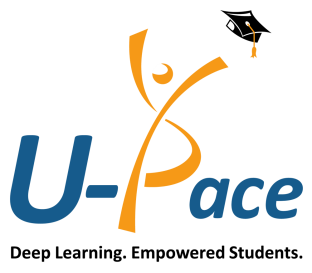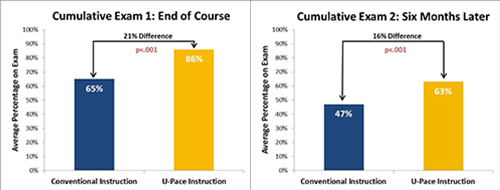The University of Wisconsin-Milwaukee is a 2014 WCET Outstanding Work Award winner for their innovative online instructional approach, U-Pace. Today Diane Reddy and Ray Fleming, co-creators of U-Pace and Laura Pedrick, executive director of UWM Online, share with us a little about the program.
Putting data into action. Valuable student data is now easily available to instructors through the Learning Management System (LMS) at their college or university. A wealth of information about each student’s work habits and progress is automatically recorded for each course. But while advances in learning management systems and learning analytics are accelerating, a gap remains between instructors’ ability to access student data and to act upon the data in an empirically-based way to fully utilize the potential to benefit their students. The U-Pace instructional approach uses information about learner engagement and performance recorded in the institution’s LMS to maximize students’ learning experience and provide personalized support for students to be successful.
 What does U-Pace mean for instructors? U-Pace is a self-paced, mastery-based online instructional approach that works within any LMS. U-Pace proactively supports learners through instructor-initiated messages called Amplified Assistance.
What does U-Pace mean for instructors? U-Pace is a self-paced, mastery-based online instructional approach that works within any LMS. U-Pace proactively supports learners through instructor-initiated messages called Amplified Assistance.
The mastery-based learning component of U-Pace consists of course content divided into small, manageable units (usually half of a chapter/lesson) that are each associated with a 10-item quiz. Students must demonstrate mastery on each unit quiz by scoring at least 90% before they can advance to new content. Retakes are unlimited (with a required one-hour wait between attempts), and consist of different quizzes that cover the same content.
Amplified Assistance consists of tailored feedback and motivational support that is emailed at least weekly to each student, which may be particularly useful for students who are struggling but reluctant to ask for help. Instructors use information recorded in the LMS to craft Amplified Assistance messages personalized for the student. Valuable information provided by most LMS’s includes:
- When was the last time the student took a quiz or accessed the course material?
- How many attempts does the student require to demonstrate mastery on a quiz?
- Are students missing questions related to one particular concept that the instructor can help clarify?
- Are students missing questions from multiple different content areas, perhaps suggesting they need assistance with their study skills and general approach to learning the material?
How does Amplified Assistance help students? In Amplified Assistance messages, instructors communicate unwavering belief in the student’s ability to succeed, and praise the student for small accomplishments (such as mastering a single quiz). Instructors also reinforce students’ effort and persistence (for example, by praising a student for consistently making attempts at a quiz they have found challenging to master), which may be especially beneficial for students who have the tendency to give up after minor set-backs. By focusing on the student’s positive behavior, instructors are shaping the student’s behavior for success. Through Amplified Assistance messages, U-Pace instructors provide the support students need to meet the high standards created by U-Pace’s mastery-based learning component, a combination which empowers students and fosters their sense of control over learning.
How can instructors create Amplified Assistance messages efficiently? Past U-Pace instructors have field-tested dozens of Amplified Assistance messages and created templates that are freely available on the U-Pace website. The variety of templates offered allows instructors to select a message from an appropriate category (e.g., “Students who are on schedule,” “Students who are behind schedule,” or “Students who have not started”) and then tailor each message based on the individual student’s performance. These templates reduce the time needed for instructors to compose effective messages to address student needs, while still offering instructors the flexibility to craft personalized messages that will be meaningful and build rapport with each student.
Does U-Pace produce results? The U-Pace instructional approach has been honored with a 2014 WCET Outstanding Work (WOW) Award. U-Pace instruction produced striking student success in multiple rigorous evaluations, including a large randomized controlled trial (where learners did not self-select their course format) funded by the U.S. Department of Education, Institute of Education Sciences, and a multi-institutional study funded by EDUCAUSE’s Next Generation Learning Challenges program. U-Pace has consistently produced greater learning and greater academic success compared to conventional face-to-face instruction. U-Pace students have scored higher than conventionally taught students on proctored, cumulative exams taken at the end of the course, and again six months later (EDUCAUSE Review Online). A greater percentage of U-Pace students (compared to conventionally taught students) have earned final grades of A or B (EDUCAUSE Learning Initiative Case Study). Furthermore, U-Pace students have shown improvements in self-regulated learning, as evidenced by a decrease in the number of attempts needed to master the quizzes over the course of the semester (Journal of Asynchronous Learning Networks).

How do students react to U-Pace instruction? Survey data has found that, relative to conventionally taught students, U-Pace students perceive greater instructor support, control over their learning, and improvements in time management and study skills over the semester (NGLC Grantee Profile, Journal of Asynchronous Learning Networks). Student reviews have mirrored these findings:
“I am actually retaining the information that I learned in this course. It has helped me out so much in boosting my confidence, and actually showing me, and opening the door, and saying you are just a step further from graduation and you can succeed because you have all these skills in you that you might have never seen before.”
“I go out and try new things, and I know that that sounds really weird, that a course can change someone like that, but you know that it is, I learned the content as well, but it is not even that, it is the fact that I am learning to be myself more, and I am opening up more doors to being motivated and having better time managing skills and being more confident in myself. Outside of school, people have noticed changes in me, that I have more of a glow to me, that I am more outgoing, almost because I have that confidence that I can actually do stuff that I used to think I had no business doing.”
Bottom line. By acting upon student data recorded in the LMS, instructors can have a meaningful impact on students. U-Pace is an empirically-tested instructional approach that has shown great success in utilizing this data to motivate, engage, and improve the learning of students. By integrating the U-Pace instructional method with LMS capabilities, instructors have the opportunity to maximize the value of these tools for guiding students to success.
If you’d like to learn more about U-Pace instruction, we’d be delighted to talk with you at the WCET Annual Meeting at one of our presentations on Thursday, November 20th: Conversation about Competency Based Education (1:30 – 2:30 pm) & U-Pace Instruction: Paving the Way to College Success (3:00 – 4:00 pm)

Diane Reddy, Co-creator of U-Pace Instruction
reddy@uwm.edu

Ray Fleming, Co-creator of U-Pace Instruction
mundo@uwm.edu

Laura Pedrick, Executive Director, UWM Online
lpedrick@uwm.edu
 What does U-Pace mean for instructors? U-Pace is a self-paced, mastery-based online instructional approach that works within any LMS. U-Pace proactively supports learners through instructor-initiated messages called Amplified Assistance.
What does U-Pace mean for instructors? U-Pace is a self-paced, mastery-based online instructional approach that works within any LMS. U-Pace proactively supports learners through instructor-initiated messages called Amplified Assistance.


